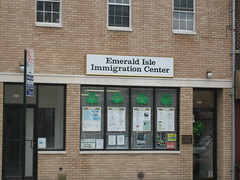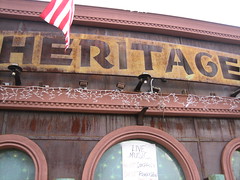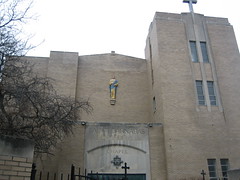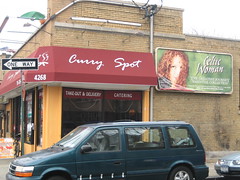Woodlawn
From The Peopling of New York City: Irish Communities
|
Neighborhoods: Woodlawn | Inwood | Hell's Kitchen | Woodhaven |
View Woodlawn & Woodlawn Heights in a larger map
Built Environment/Economy
What is Woodlawn?
The Bronx is home to the most well known Irish neighborhood in New York City, Woodlawn. Dubbed “Little Ireland”, Woodlawn seems to be the most densely concentration of new Irish immigrants and has an extremely strong connection to their homeland and culture. Woodlawn is an extremely residential area with a mixture of apartment buildings, private houses and multi-family homes. Almost all businesses are located on street level or in their own individual buildings.
Neighborhood Boundaries
The Woodlawn area is interesting because it has unusually clear boundaries, which contain a plethora of Irish businesses and homes.
The southern border is the famous Woodlawn Cemetery, home to hundreds of famous and influential people such as Duke Ellington and Celia Cruz. Simply by walking through the cemetery one is able to see the influence of the Irish community through the Irish names and Celtic symbols on the tombstones. [1]
The northern boundary is McLean Avenue, and the Yonkers city border. This boundary is intriguing because the Yonkers border goes directly down the avenue and both sides, despite being in two different cities are often commonly thought of as a part of Woodlawn.
The western and eastern borders are the northern extension of Van Cortlandt Park and Webster Road.
Although the Irish community does extend to other places, part of the reason that the area is so concentrated and the boundaries are so specific is that Woodlawn is the only area with housing, being surrounded in the most part by a park, cemetery and major road.
Evidence of Irish Culture
The culture in Woodlawn is predominantly Irish; shamrocks adorn almost every building, the streets are lined with Irish food stores, pubs, restaurants and most signs have some form of Celtic lettering. There are banners attached to lampposts designating the area as a historical neighborhood, Little Ireland.
The main social establishments are the pubs and the large Catholic Church that the majority of the neighborhood frequent, St. Barnabas. In pubs and restaurants the patrons eat and drink with their families while conversing and watching Gaelic football and European Soccer.
Also, there is no apparent occupational hierarchy depending on how long they've been here; recent immigrants work in every type of job from owning businesses to being waiters and waitresses.
The only language that seems to be spoken at all by the Irish community is English. There is no evidence of the original Gaelic Irish besides sayings such as “Erin Go Bragh”.
There are also many periodicals such as magazines and newspapers focusing dually on the American and New York aspect of their lives and quite equally, events occurring in Ireland. In general there is an intense maintenance of the Irish culture that is blatantly obvious in every aspect of life in Woodlawn. [2]
Woodlawn contains two main avenues with the strongest concentration of Irish Immigrants and their descendants, Katonah Avenue and McLean Avenue. These streets are lined with Irish owned businesses and homes and are the main areas of mingling. The main school that most children attend is P.S. 19, which teaches kindergarten through the eighth grade and acts as a community center for Woodlawn. On McLean Avenue, the main church, St. Barnabas, has a similar but catholic school that many children in the area also attend and has an all girl high school that many parents send their children to.
On these two avenues, there is a concentration of businesses/restaurants that all cater to the community’s needs and are constantly packed with the Woodlawn residents, this is where the people come together to socialize and maintain their culture.
One thing that is extremely interesting about the community in Woodlawn is the importance to people and families of representing not just Ireland, but their respective provinces back home.
While the people all feel connected, being from the same country, there are rivalries and competition based on their towns and families, Gaelic football teams are even organized as such. Respecting and remembering exactly where they came from gives the people a stronger sense of identity and keeps old friends close, it is another way in which they maintain many of the things the loved in their new country.
Other Cultures Present in Neighborhood
Even though Woodlawn retains the title of "Little Ireland", there are evidence of other ethnic groups slowly seeping into the area.
Establishments that seem "Irish" at a first glance, yet their employees (such as busboys and etc.) are oftentimes Latinos.
Still, one should remember that this is a phenomenon that can be widely observed in rest of the city. Thus, it is a further indicator of how influential the Latino immigrant population may be in the future. And in a way, the history of Irish immigration in the late nineteenth and early twentieth century parallels that of the Latinos in present day New York
One major similarity is the prevalence of Roman Catholicism in both cultures. The newly appointed leader of the New York Archdiocese, Archbishop Timothy M. Dolan (of Irish descent) can conduct mass in Spanish.





